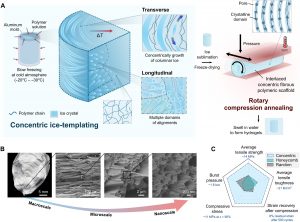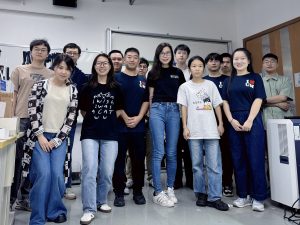A research team led by Lei Iek Man, assistant professor in the Department of Electromechanical Engineering of the Faculty of Science and Technology (FST) at the University of Macau (UM), has developed a novel concentric ice-templating technique that constructs hydrogels with bioinspired circumferentially aligned fibrous structures. This breakthrough overcomes the limitations of traditional ice-templating methods, which can only produce simple structures such as honeycomb or lamellar structures. The new approach significantly improves the mechanical properties of hydrogels in terms of compression, toughness, and fatigue resistance, thereby expanding the scope of application of the ice-templating method and improving the mechanical properties of artificial hydrogels. The findings have been published in Science Advances, an internationally renowned multidisciplinary journal.
Natural materials with circumferential fibrous structures, such as intervertebral discs, arteries, and fish swim bladders, possess remarkable mechanical properties. Although traditional ice-templating can create bioinspired structures through controlling directional ice growth, the range of achievable structures remains severely limited and these techniques are often costly and inefficient, making it difficult to replicate the mechanical performance derived from the structures of natural materials. The research team discovered that slow freezing could induce ice crystals to grow parallel to the cooling source. Based on this insight, they, for the first time, developed ‘concentric ice-templating’ to construct circumferential fibrous structures in hydrogels. Additionally, the team improved existing annealing techniques by introducing a ‘rotary compression annealing’ strategy to densify the microstructure and increase its crystallinity. With these approaches, the resulting hydrogel retains a high water content (85 wt.%) while achieving multiple mechanical advantages, including high strength, toughness, fatigue resistance, compressibility, and burst pressure.
This innovative bionic hydrogel holds broad application potential, particularly in soft robotics and tissue engineering. It can be used to develop hydrogel pneumatic actuators with high actuation force, soft grippers for handling delicate objects, bionic robotic fish, and underwater camouflage soft robots.
Prof Lei is the corresponding author of the study, and Gu Wenxi, a doctoral student in FST, is the first author. The research project was supported by the Science and Technology Development Fund of the Macao SAR (File No.: 0119/2022/A3, 0009/2023/ITP1, 0113/2024/RIB2), UM, and the University of Macau Development Foundation (File No.: SRG2022-00038-FST, MYRG-GRG2023-00225-FST-UMDF). The full version of the research article is available at: https://www.science.org/doi/10.1126/sciadv.adv7786.
| Source: Faculty of Science and Technology | |
| Media Contact Information: | |
| Communications Office, University of Macau | |
| Albee Lei | Tel: (853) 8822 8004 |
| Bell Leong | Tel: (853) 8822 8009 |
| Email: | prs.media@um.edu.mo |


